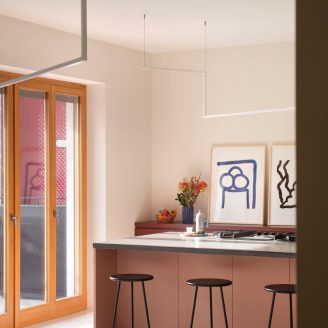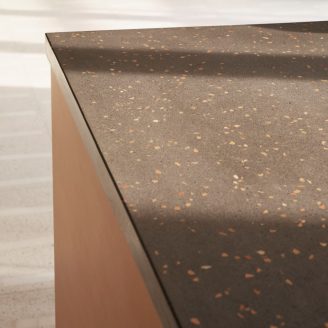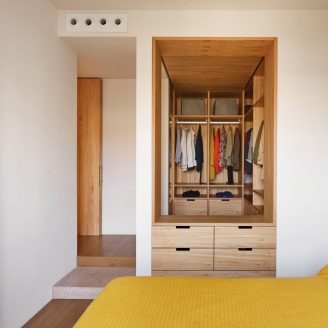Colour, matter and space. These are the fundamentals of A Material Wonderland, the apartment redesigned by ATOMAA Studio in a 1960’s building in Milan.
The removal of the corridor leaves the field free to the forgotten spaces of the vestibule, the writing nook, the dressing room, the boudoir, the bathroom, the kursaal, the playroom, the alcove, the conservatory, the laundry, the galley, the bar. The inhabitants of this house can hide in the intimacy of these rooms; or choose, when the time is ripe, to meet in the spacious common “piazza” of the living room.
The large space for convivial activities reflects the light of three large windows; left without curtains, like those of northern cities. The backdrop of this space is dominated by the large island with five gas burners, the real hearth of the house. With its colours inspired by Giorgio Morandi, this space wants to remain ambiguous, in order to accommodate more formal events when necessary. Thus a long sideboard, the colour of a deep red wine, meets a long sand-colored boiserie which, in addition to containing the basic needs of the kitchen, can hide the sink, transforming the space into a ballroom. Thus, the embossed lacquers resound like velvet when touched by the hand while the veining of the elm that covers the kitchen combines with the fresh and smooth surface of the concrete surfaces, unique fusions of black cement embellished with a Verona red.
At the other end of the “piazza”, in juxtaposition, a more intimate environment devoted to music and acts of contemplation. Part bow window and part winter garden, this place is characterized by the presence of a small wooden alcove whose deep seat invites a lazy reader. The blown glass lantern and the velvet complete the scenery and the intimacy of this world is signaled by the change of floor which, in scented wood, approaches the minerality of the most important floor of the house.
The decommissioning of a worn-out parquet revealed before our eyes a vibrant composition: the structure of the joists “sown” by the hand of a forgotten craftsman designed a mesmerizing texture. The design of the new terrazzo floor and thassos tiles is uncertain and “a little wrong”, and is meant to be an ode to that forgotten hand.
In contrast to the delicate white paving that flows beneath, the warm pigmented stair creates a space of spontaneous on-the-go conversation, or even a small seat for a moments pause. Perched lightly above the living space, tracing the outline of an old bathroom window that once was, a new framed view immerges, creating a private writing desk and drinks bar.
The passage between the more social areas of the house and the more intimate ones is accompanied by the sensitive experience of the scent of wood. It takes place through a room covered in a boiserie: the panels hide and disclose other rooms – some of services such as galley and laundry, others a bit special (like the bar) dedicated to the pleasure of guests.
Behind one of these secret doors, sits a compact guest washroom, bathed in a vibrating wash of zellige tiles; a lively patchwork of individually handcrafted tiles immerges, each one different from the other. A custom-made concrete wash basin stands proud, it’s presence like a stone monolith paying tribute to a moment in history, while from above, a high-level window brings in soft natural light.
Through another openable panel, access to the matrimonial suite is granted. Continuing its warm timber finish, light beams into the compact walk-in wardrobe, through a large opening with a bench at its base. Separating the walk-in wardrobe from the main bedroom, yet another precious element in pigmented concrete sits atop a warm timber floor. This inserted element, also taking on the function of a small seat, spills ever so slightly into the bedroom, inviting the arrival of its guests.
In this compact and private world, composed of 3 rooms in 1, the en-suite bathroom is thought to take on the function of a private spa. For the sake of simplicity, two bold contrasting colours are used in two main forms. The walls, shower and large bath for two are wrapped in black zellige tiles, reflecting a shimmering light, both natural and artificial, depending on the time of day. A custom wash basin in white concrete, formed at the hands of an experienced artisan, rests lightly on the dark grounded bath volume. In an opposing world, while still a space of purity and self-care, an exotic and vibrant green zellige tile pays reference to those great façade designers of the 60s; material raincoats which still hold strong against a rapidly changing urban skyline.






























